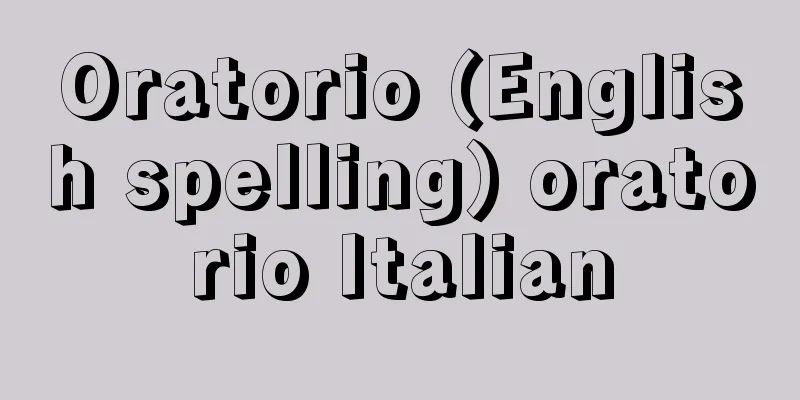Oratorio (English spelling) oratorio Italian

|
It is translated as "sacred tale". It is a grand narrative piece of music based on a religious theme, and like opera, it uses soloists, chorus, and orchestra, but except for early works, it usually does not include acting, scenery, or costumes. Throughout its history, the emphasis has been on the chorus, and it is also characterized by the presence of a narrator who carries the story. Its direct origin is in the musical style of the Oratorio Society (derived from the prayer room (oratorio) where the meetings were held) that was started by St. Filippo Neri (1515-95) in the late 16th century at a church in Rome. However, it was not until the mid-17th century that the word oratorio came to refer to a certain musical style. During this period, there were two types of oratorio: Latin oratorio and vulgar (Italian) oratorio, but the latter gradually came to be preferred, and the Latin oratorio disappeared in the late 17th century. An important composer in the mid-17th century was Calissimi (1605-1674), who established the Latin oratorio and perfected its style. The oratorio, which had been cultivated in Italy, encountered the tradition of "Passion music" in Germany, which opened up new horizons. Among them, Schütz built the foundations of the German oratorio, a tradition that was continued in the 18th century by Bach and Telemann. In England, Handel returned to Calissimi's choral oratorio, taking its dramatic potential to the limit and perfecting the classical oratorio. His most famous works are Israel in Egypt (1739) and Messiah (1742). Oratorio composition stagnated for a while after Handel, but in the 18th century, Haydn went to Austria and once again reached a high level. His two great masterpieces, The Creation (1798) and The Seasons (1801), are magnificent works that incorporate instrumental elements into Handel's choral technique. The greatest oratorio composer of the 19th century was Mendelssohn, who wrote two masterpieces, St. Paul (1836) and Elia (1846). Liszt, Berlioz, and Franck also produced excellent works. Among the oratorios of the 20th century, religious works include Honegger's King David (1921) and Jean Françaix's The Apocalypse of St. John (1942), while important secular oratorios include Stravinsky's Oedipus Rex (1927), Prokofiev's The Guardian of Peace (1950), and Shostakovich's Forest Song (1949). [Jiro Isobe] Source: Shogakukan Encyclopedia Nipponica About Encyclopedia Nipponica Information | Legend |
|
「聖譚(せいたん)曲」と訳される。一般に宗教的題材に基づく壮大な叙事的楽曲で、オペラと同様に独唱、合唱、管弦楽を用いるが、初期の作品を除けば、演技や背景、衣装を伴わないのが通例である。オラトリオの全歴史を通じて合唱に重点が置かれ、物語の筋を運ぶ語り手の存在も特徴となっている。直接の起源は、16世紀後半、聖フィリッポ・ネーリ(1515―95)がローマの教会で始めたオラトリオ会(集会が開かれた祈祷室(オラトリオ)に由来する)における楽種にある。しかしオラトリオという語が一定の音楽形式を表すようになったのは、17世紀中ごろからである。この時期にはラテン語オラトリオと俗語(イタリア語)オラトリオの2タイプがあったが、しだいに後者が好まれるようになり、ラテン語のものは17世紀後期に姿を消した。17世紀中ごろの重要な作曲家はカリッシミ(1605―74)で、彼はラテン語オラトリオを確立するとともに、オラトリオの様式を完成した。イタリアではぐくまれたオラトリオは、ドイツで「受難曲」の伝統と出会い、新生面が開かれた。なかでもシュッツはドイツ語オラトリオの礎(いしずえ)を築き、その伝統は大バッハやテレマンによって18世紀に受け継がれた。イギリスではヘンデルがカリッシミの合唱オラトリオに帰って、劇的可能性を極限にまで高め、古典的オラトリオを完成した。『エジプトのイスラエル人』(1739)、『救世主(メサイア)』(1742)はとくに有名である。 オラトリオの創作はヘンデル以後しばらく沈滞するが、18世紀にはハイドンがオーストリアに出て、ふたたび高い水準に達した。『天地創造』(1798)、『四季』(1801)は彼の二大傑作で、ヘンデルの合唱技法に器楽的要素を大いに取り入れた壮麗な作品である。19世紀のもっとも優れたオラトリオ作曲家はメンデルスゾーンで、『聖パウロ』(1836)と『エリア』(1846)の二つの傑作がある。リスト、ベルリオーズ、フランクにも優れた作品がある。 20世紀のオラトリオには、宗教的な作品として、オネゲルの『ダビデ王』(1921)、ジャン・フランセーの『聖ヨハネの黙示録』(1942)などがある。また世俗的なオラトリオとして重要な作品は、ストラビンスキーの『オイディプス王』(1927)、プロコフィエフの『平和の守り』(1950)、ショスタコビチの『森の歌』(1949)などである。 [磯部二郎] 出典 小学館 日本大百科全書(ニッポニカ)日本大百科全書(ニッポニカ)について 情報 | 凡例 |
<<: Oratorio Society - Oratorio Society
Recommend
Semipelagianism
...The controversy became even more intense when ...
Ganges susu (English spelling) Gangessusu
...The Ganges River Dolphin, Platanista gangetica...
Iitani - Good
...Located north of Lake Hamana, the Tenryu Haman...
Fukumitsu [town] - Fukumitsu
A former town in Nishitonami County in western Toy...
Political police - Seiji Keisatsu (English spelling)
A division of the administrative police, also kno...
Bilhaa (English spelling)
Date of birth and death unknown. An Indian Sanskr...
Asian red-breasted thrush
...It is distributed from Sagami Bay to Kyushu, a...
Orthofilm - Orsofilm
... The silver halide used as a photosensitive ma...
Yoshio Farming
A Dutch interpreter and doctor of Western medicin...
reference equivalent
...As shown in the table, evaluation scales such ...
Capuchin Monkey - Omakizaru
In a broad sense, it is a general term for animal...
Meiji Girls' School
Kimura Abiko founded this girls' school in 188...
Kunyozushiki - Konyozushiki
The most outstanding world geography book from the...
Foot art - Ashigei
A type of acrobatics. Also called kyokumochi. Lyi...
Regimen sanitatis salernitanum
...There were already famous physicians there in ...









